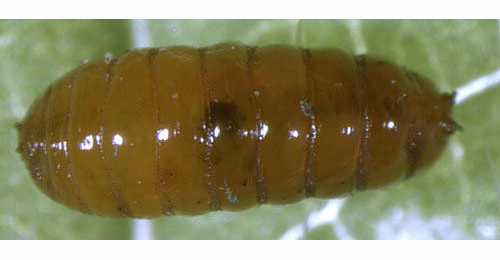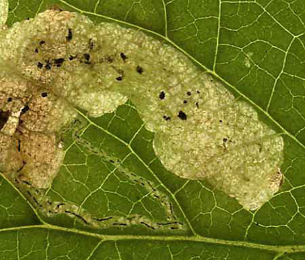|
||||||
|
LEONURUS. Motherworts. [Lamiaceae] |
|
|
Two species of Leonurus are recorded in Britain. Both are introduced. Four British miners are recorded on Leonurus. A key to the European miners recorded on Leonurus is provided in Bladmineerders van Europa. |
Key for the identification of the known mines of British |
||||||||||||||||||
1a > Leaf-miner: A linear-blotch mine, first instar mine is linear, later developing into a conspicuous white blotch. Frass greenish diffused (Spencer, 1972b: 46, 47 (fig. 138); Spencer, 1976: 166). The mine begins with a long, upper-surface, slender corridor. After a moult the larva changes its behaviour, and makes a large, upper-surface primary blotch without apparent feeding lines. Often the blotch overruns more or less the initial corridor. Frass in the corridor liquified to form a wide green band, with a few tiny black granules along the sides. Pupation outside the mine. A narrow gallery leading to a largish blotch on the upper surface. Frass is green and indistinct in the gallery - small grains may be seen at the gallery edge. |
||||||||||||||||||
 Amauromyza labiatarum puparium Image: © Willem Ellis (Bladmineerders van Europa) |
||||||||||||||||||
|
||||||||||||||||||
Amauromyza labiatarum (Hendel, 1920) [Diptera: Agromyzidae]. |
||||||||||||||||||
| 1b > Leaf-miner: Initially a long, slim corridor, the frass alternating on either the side of the corridor. After moulting, the larva broadens the mine and the frass is less regular. Pupation external. | ||||||||||||||||||
 Mine of Amauromyza lamii on Stachys sylvatica Image: © Willem Ellis (Bladmineerders van Europa) |
||||||||||||||||||
|
||||||||||||||||||
| Amauromyza lamii (Kaltenbach, 1858) [Diptera: Agromyzidae]. | ||||||||||||||||||
1c > Leaf-miner: A short, irregular, linear upper surface mine on any part of the leaf. Also recorded from young pods (Bland, 1997a). Long corridor mine. As a rule the first part of the mine is lower-surface, the later part upper-surface. Often the loops are so dense that a secondary blotch is the result. Because upper- and lower-surface corridor segments often cross, the mine obtains a strange array of transparant patches. There is no association with the midrib. Frass in strings and thread fragments. Pupation outside the mine; exit slit in upper epidermis. Mine not associated with the veins or midrib of the leaf (It is this character which enables distinction from another Agromyzid pest species - Liriomyza huidobriensis). The larvae may leave one leaf (if not large enough) and enter another leaf, via the petiole). It exits the leaf to pupate through a semi-circular slit in the upper surface of the leaf. |
||||||||||||||||||
|
||||||||||||||||||
Liriomyza bryoniae (Kaltenbach, 1858) [Diptera: Agromyzidae]. |
||||||||||||||||||
1d > Leaf-miner: A distinctive mine primarily above mid-rib, with irregular short lateral offshoots into leaf blade. Pupation external (Spencer, 1972: 51 (fig. 172), 55; Spencer, 1976: 270, 271 (fig. 486)). Branched, whitish, upper-surface corridor; main axis overlying the midrib; side branches overlying the main lateral veins. (In Campanula and Phyteuma the mine is much less branched, sometimes nothing more than a corridor on top of the midrib). Frass in rather long strings. Usually the mines begins as a long and narrow, shallow, tortuous lower-surface corridor that ends upon the midrib but otherwise is not associated with the leaf venation. Often this initial corridor is filled with callus, and then even less conspicuous. Pupation outside the mine. A linear mine on the upper surface, usually following the midrib and showing side branches along the veins. The frass is in strings. |
||||||||||||||||||
|
||||||||||||||||||

